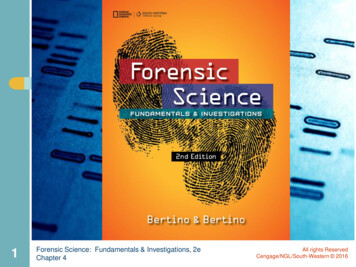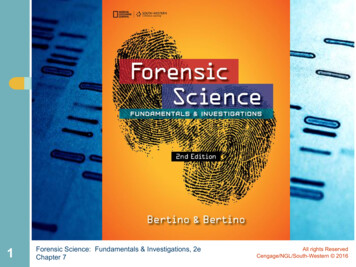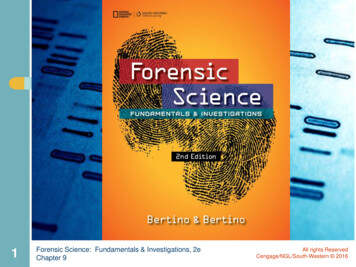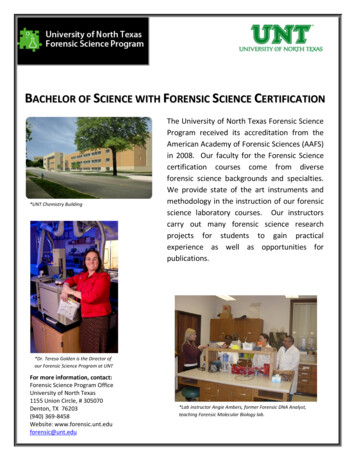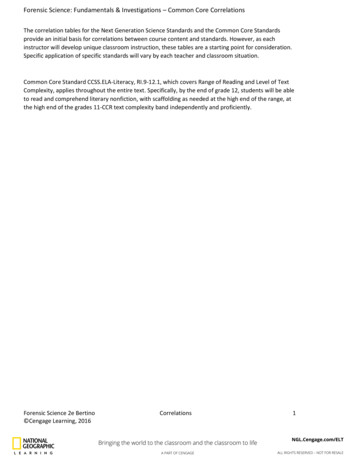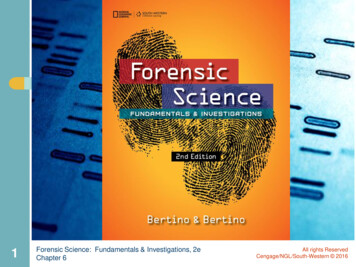
Transcription
1Forensic Science: Fundamentals & Investigations, 2eChapter 6All rights ReservedCengage/NGL/South-Western 2016
Frontline the real /oFF Death by a salesman https://www.youtube.com/watch?v GE2CpmKdzgFF point of origin https://www.youtube.com/watch?v ffM1pHuILhkOnline links ng killers llers/fingerprints/1003122/141423FF bagging a killer https://www.youtube.com/watch?v Bg42zy0OhSQKahoot review 544a620b27a72Forensic Science: Fundamentals & Investigations, Chapter 6
Chapter 6 FingerprintsBy the end of this chapter you will be able to:6.1 Outline the history of fingerprinting.6.2 Describe the characteristics of fingerprints.6.3 Compare and contrast the basic types offingerprints.6.4 Describe how criminals attempt to altertheir fingerprints.6.5 Present and refute arguments that questionfingerprint evidence reliability.3Forensic Science: Fundamentals & Investigations, 2eChapter 6All rights ReservedCengage/NGL/South-Western 2016
Chapter 6 FingerprintsBy the end of this chapter you will be able to:6.6 Summarize the proper procedures forcollecting fingerprint evidence.6.7 Describe the latest identification technologies.6.8 Determine if a fingerprint is consistent with afingerprint on record.6.9 Lift a latent print.6.10 Prepare a ten card and analyze the ridgepatterns of the prints.4Forensic Science: Fundamentals & Investigations, 2eChapter 6All rights ReservedCengage/NGL/South-Western 2016
Chapter 6Vocabularyooooooo5archcoredeltafingerprintIAFIS (IntegratedAutomated FingerprintIdentification System)latent fingerprintloopominutiaepatent fingerprintplastic fingerprintridge countridge patternten cardowhorloooooForensic Science: Fundamentals & Investigations, 2eChapter 6All rights ReservedCengage/NGL/South-Western 2016
IntroductionooPudd’nhead Wilson waspublished in 1894.Pudd’nhead Wilson states thata suspect’s fingerprints are: 6“his signature, his physiologicalautograph, so to speak, and thisautograph cannot becounterfeited, nor can hedisguise it or hide it away, norcan it become illegible by thewear and mutations of time.”Forensic Science: Fundamentals & Investigations, 2eChapter 6All rights ReservedCengage/NGL/South-Western 2016
Historyooooo7Ancient cultures used fingerprints as personalmarkings.Ancient Babylon 1792-1750 B.C. — Fingerprintswere pressed into clay tablet contracts.1684 — Dr. Nehemiah Grew described the patternson human hands including ridges1788 — Johann Mayer fingerprints are unique toeach individual.1823 – Jan Evangelist Purkyn described ninefingerprint patterns.Forensic Science: Fundamentals & Investigations, 2eChapter 6All rights ReservedCengage/NGL/South-Western 2016
History (continued)ooo1856 — Sir William Herschel began collectingfingerprints- noted not altered by age1879 — Alphonse Bertillon created a way toidentify criminals that were repeat offenders.1888 — Sir Francis Galton verified thatfingerprints do not change with age. Also with Sir Henry made classification system stillused today1896 — Sir Edmund Richard Henry (andcolleagues) created a system that dividedfingerprint records into groups. basis of tencard.ForensicScience: Fundamentals & Investigations, 2eo8Chapter 6All rights ReservedCengage/NGL/South-Western 2016
9Forensic Science: Fundamentals & Investigations, 2eChapter 6All rights ReservedCengage/NGL/South-Western 2016
10Forensic Science: Fundamentals & Investigations, 2eChapter 6All rights ReservedCengage/NGL/South-Western 2016
History (continued)o2012 — FBI- IAFIS system had more than 76million computerized fingerprints, mugshots, scars,tattoo photos, and other identification records. o2013 — The FBI compare palm prints 11The system will soon be enhanced by AdvancedFingerprint Identification Technology (AFIT).About 20-30% of latent prints at a crime scene come fromthe palm or side of the hand from the little finger to thewrist.Forensic Science: Fundamentals & Investigations, 2eChapter 6All rights ReservedCengage/NGL/South-Western 2016
What Are Fingerprints?oImpressions (of ridges) made by fingers, toes,feet, and palms 12Ridges help us grip objectsRidges are arranged in connected units called dermal, or friction, ridgesFingers accumulate natural secretions and dirtFingers leave create prints on objects we touchForensic Science: Fundamentals & Investigations, Chapter 6
What Are Fingerprints?oFormation of Fingerprints 13formed beginning at the 10th week of gestation.in the basal layer of skin.protected by the outer epidermis.Forensic Science: Fundamentals & Investigations, 2eChapter 6All rights ReservedCengage/NGL/South-Western 2016
Structure of SkinOuter layer epidermisInner layerdermisBasal layer Basal layer growsfaster than the layersabove and below it Basal layer collapsesand folds to formintricate shapes Fingerprints beginforming near the 10thweek of pregnancy14Forensic Science: Fundamentals & Investigations, Chapter 6
15Forensic Science: Fundamentals & Investigations, 2eChapter 6All rights ReservedCengage/NGL/South-Western 2016
Characteristics of FingerprintsoThere are 3 general fingerprint distinctions:ARCHWHORLLOOPAbout 5%About 30%About 65%of the population16Forensic Science: Fundamentals & Investigations, Chapter 6
CharacteristicsoForensic examiners look for oRidge count 17Core(the center of a whorl or loop)Deltas(triangular regions near a loop)Counting from the core to theedge of the deltaDistinguishes one fingerprintfrom anotherForensic Science: Fundamentals & Investigations, Chapter 6
Characteristics ofFingerprints (continued)18Forensic Science: Fundamentals & Investigations, 2eChapter 6All rights ReservedCengage/NGL/South-Western 2016
Characteristics of FingerprintsoBasic patterns can be further divided: Arch patterns: 4% plain 1% tented Whorl patterns: 2% central pocket 4% double loop 0.01% accidentalo19Even twins have unique fingerprintsForensic Science: Fundamentals & Investigations, Chapter 6
Characteristics of Fingerprints20Forensic Science: Fundamentals & Investigations, Chapter 6
Characteristics of Fingerprints21Forensic Science: Fundamentals & Investigations, Chapter 6
Characteristics of Fingerprints(continued)22Forensic Science: Fundamentals & Investigations, 2eChapter 6All rights ReservedCengage/NGL/South-Western 2016
23Forensic Science: Fundamentals & Investigations, 2eChapter 6All rights ReservedCengage/NGL/South-Western 2016
Types of FingerprintsThere are 3 types of prints that investigatorslook for at crime scenes:1. Patent fingerprints—visible prints transferredonto smooth surfaces by blood or other liquids2. Plastic fingerprints—indentations left in softmaterials such as clay or wax3. Latent fingerprints—made visible by dustingwith powders or the use of chemicals24Forensic Science: Fundamentals & Investigations, Chapter 6
Types of Fingerprints25Forensic Science: Fundamentals & Investigations, 2eChapter 6All rights ReservedCengage/NGL/South-Western 2016
Fingerprint Forensic FAQsoCan fingerprints be erased?Only temporarily; they will grow back if removed with chemicalsoIs fingerprint identification reliable?Yes, but analysts can make mistakesoCan computers perform matches in seconds?No, but the FBI’s Integrated Automated Fingerprint IdentificationSystem (IAFIS or AFIS) can provide a match in 2 hours26Forensic Science: Fundamentals & Investigations, Chapter 6
Fingerprint Forensic FAQso27How are latent fingerprints collected?Forensic Science: Fundamentals & Investigations, Chapter 6
28Forensic Science: Fundamentals & Investigations, 2eChapter 6All rights ReservedCengage/NGL/South-Western 2016
29Forensic Science: Fundamentals & Investigations, 2eChapter 6All rights ReservedCengage/NGL/South-Western 2016
30Forensic Science: Fundamentals & Investigations, 2eChapter 6All rights ReservedCengage/NGL/South-Western 2016
The Futureooooscanned at a resolution of 500 to 1000 dotsper inch.Analyze trace elements on skinNanoparticles added to powders makingpoor patterns appear even sharper. Technologies that recognize patterns in RetinaFace Veins in your palmForensic Science: Fundamentals & Investigations, 2e 31Chapter 6All rights ReservedCengage/NGL/South-Western 2016
32Forensic Science: Fundamentals & Investigations, 2eChapter 6All rights ReservedCengage/NGL/South-Western 2016
33Forensic Science: Fundamentals & Investigations, 2eChapter 6All rights ReservedCengage/NGL/South-Western 2016
Summaryooo34Humans have noticed the patterns on their hands for thousands of years,but it was not until 1684 that these patterns were described in detail. In themid-1800s, the idea of a fingerprint’s uniqueness was studied, and theapplication of fingerprints to an identification system began. By the late1800s, two effective systems were being used to identify criminals, andfingerprints were being collected as evidence in crimes.The elevated regions in a fingerprint are called friction ridges. Fingerprintsconsist of several main ridge patterns, including whorls, loops, and arches.They have a core, which is an area where ridges separate or unite afterrunning in a parallel direction. The triangular region located near a looppattern, or whorl, is called a delta.Fingerprints are formed in the womb at about week 10 of gestation. Theyare formed between two layers of skin, and their shape does not changeduring a person’s lifetime. They are unique to an individual. Not evenidentical twins have identical fingerprints.Forensic Science: Fundamentals & Investigations, 2eChapter 6All rights ReservedCengage/NGL/South-Western 2016
Summary (continued)ooo35Fingerprints left on an object are created by the naturally occurringridges in the skin of fingertips and secretions from sweat glandsthat leave small amounts of oils and salts when the ridges arepressed against an object. The residues leave an impression of theridges found on the finger of the donor.The basic types of fingerprints are patent (visible) fingerprints,plastic (indentation) fingerprints, and latent (not visible to theunaided eye) fingerprints. They are characterized as loops, whorls,or arches, and are compared on the basis of their minutiae.Criminals have sought to alter their fingerprints with chemicals,surgery, and superficial destruction. Some fingerprints cantemporarily be altered by long-term contact with rough surfaces.Attempts at permanent fingerprint alteration have not beensuccessful.Forensic Science: Fundamentals & Investigations, 2eChapter 6All rights ReservedCengage/NGL/South-Western 2016
Summary (continued)ooo36Mistakes in fingerprint analysis have led to wrongfulconvictions, mostly because of human error. New forensicstandards are being developed through the ScientificWorking Groups and the Organization of Scientific AreaCommittees.The Integrated Automated Fingerprint Identification System(IAFIS) is a national database that holds more than 76million fingerprint, identifying mark, and criminal historyrecords.Fingerprints can be collected from surfaces by dusting themwith certain powders and impressing them on tape, orputting them into contact with certain chemicals that helpreveal the fingerprints.Forensic Science: Fundamentals & Investigations, 2eChapter 6All rights ReservedCengage/NGL/South-Western 2016
All rights Reserved Cengage/NGL/South-Western 2016 Forensic Science: Fundamentals & Investigations, 2e Chapter 6 Introduction o Pudd'nhead Wilson was published .


